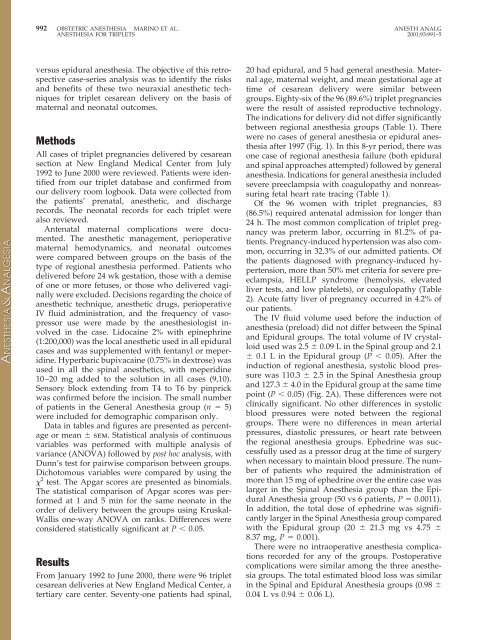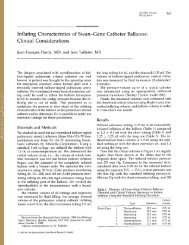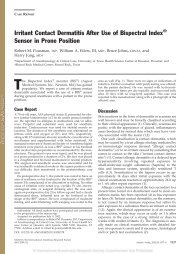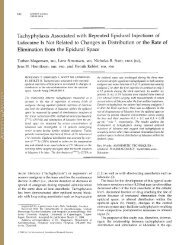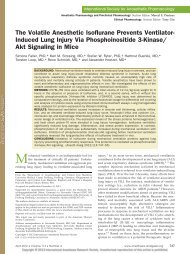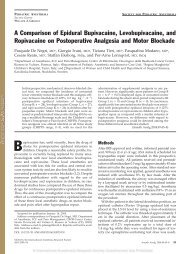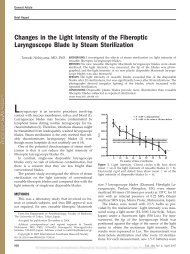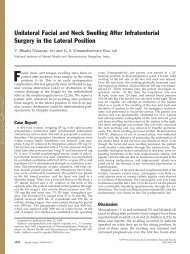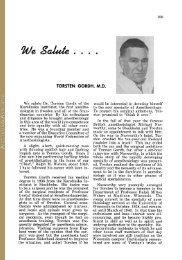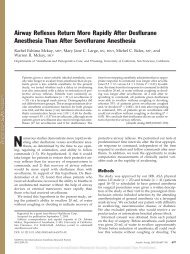The Anesthetic Management of Triplet Cesarean Delivery: A ...
The Anesthetic Management of Triplet Cesarean Delivery: A ...
The Anesthetic Management of Triplet Cesarean Delivery: A ...
You also want an ePaper? Increase the reach of your titles
YUMPU automatically turns print PDFs into web optimized ePapers that Google loves.
992 OBSTETRIC ANESTHESIA MARINO ET AL. ANESTH ANALG<br />
ANESTHESIA FOR TRIPLETS 2001;93:991–5<br />
versus epidural anesthesia. <strong>The</strong> objective <strong>of</strong> this retrospective<br />
case-series analysis was to identify the risks<br />
and benefits <strong>of</strong> these two neuraxial anesthetic techniques<br />
for triplet cesarean delivery on the basis <strong>of</strong><br />
maternal and neonatal outcomes.<br />
Methods<br />
All cases <strong>of</strong> triplet pregnancies delivered by cesarean<br />
section at New England Medical Center from July<br />
1992 to June 2000 were reviewed. Patients were identified<br />
from our triplet database and confirmed from<br />
our delivery room logbook. Data were collected from<br />
the patients’ prenatal, anesthetic, and discharge<br />
records. <strong>The</strong> neonatal records for each triplet were<br />
also reviewed.<br />
Antenatal maternal complications were documented.<br />
<strong>The</strong> anesthetic management, perioperative<br />
maternal hemodynamics, and neonatal outcomes<br />
were compared between groups on the basis <strong>of</strong> the<br />
type <strong>of</strong> regional anesthesia performed. Patients who<br />
delivered before 24 wk gestation, those with a demise<br />
<strong>of</strong> one or more fetuses, or those who delivered vaginally<br />
were excluded. Decisions regarding the choice <strong>of</strong><br />
anesthetic technique, anesthetic drugs, perioperative<br />
IV fluid administration, and the frequency <strong>of</strong> vasopressor<br />
use were made by the anesthesiologist involved<br />
in the case. Lidocaine 2% with epinephrine<br />
(1:200,000) was the local anesthetic used in all epidural<br />
cases and was supplemented with fentanyl or meperidine.<br />
Hyperbaric bupivacaine (0.75% in dextrose) was<br />
used in all the spinal anesthetics, with meperidine<br />
10–20 mg added to the solution in all cases (9,10).<br />
Sensory block extending from T4 to T6 by pinprick<br />
was confirmed before the incision. <strong>The</strong> small number<br />
<strong>of</strong> patients in the General Anesthesia group (n 5)<br />
were included for demographic comparison only.<br />
Data in tables and figures are presented as percentage<br />
or mean sem. Statistical analysis <strong>of</strong> continuous<br />
variables was performed with multiple analysis <strong>of</strong><br />
variance (ANOVA) followed by post hoc analysis, with<br />
Dunn’s test for pairwise comparison between groups.<br />
Dichotomous variables were compared by using the<br />
2 test. <strong>The</strong> Apgar scores are presented as binomials.<br />
<strong>The</strong> statistical comparison <strong>of</strong> Apgar scores was performed<br />
at 1 and 5 min for the same neonate in the<br />
order <strong>of</strong> delivery between the groups using Kruskal-<br />
Wallis one-way ANOVA on ranks. Differences were<br />
considered statistically significant at P 0.05.<br />
Results<br />
From January 1992 to June 2000, there were 96 triplet<br />
cesarean deliveries at New England Medical Center, a<br />
tertiary care center. Seventy-one patients had spinal,<br />
20 had epidural, and 5 had general anesthesia. Maternal<br />
age, maternal weight, and mean gestational age at<br />
time <strong>of</strong> cesarean delivery were similar between<br />
groups. Eighty-six <strong>of</strong> the 96 (89.6%) triplet pregnancies<br />
were the result <strong>of</strong> assisted reproductive technology.<br />
<strong>The</strong> indications for delivery did not differ significantly<br />
between regional anesthesia groups (Table 1). <strong>The</strong>re<br />
were no cases <strong>of</strong> general anesthesia or epidural anesthesia<br />
after 1997 (Fig. 1). In this 8-yr period, there was<br />
one case <strong>of</strong> regional anesthesia failure (both epidural<br />
and spinal approaches attempted) followed by general<br />
anesthesia. Indications for general anesthesia included<br />
severe preeclampsia with coagulopathy and nonreassuring<br />
fetal heart rate tracing (Table 1).<br />
Of the 96 women with triplet pregnancies, 83<br />
(86.5%) required antenatal admission for longer than<br />
24 h. <strong>The</strong> most common complication <strong>of</strong> triplet pregnancy<br />
was preterm labor, occurring in 81.2% <strong>of</strong> patients.<br />
Pregnancy-induced hypertension was also common,<br />
occurring in 32.3% <strong>of</strong> our admitted patients. Of<br />
the patients diagnosed with pregnancy-induced hypertension,<br />
more than 50% met criteria for severe preeclampsia,<br />
HELLP syndrome (hemolysis, elevated<br />
liver tests, and low platelets), or coagulopathy (Table<br />
2). Acute fatty liver <strong>of</strong> pregnancy occurred in 4.2% <strong>of</strong><br />
our patients.<br />
<strong>The</strong> IV fluid volume used before the induction <strong>of</strong><br />
anesthesia (preload) did not differ between the Spinal<br />
and Epidural groups. <strong>The</strong> total volume <strong>of</strong> IV crystalloid<br />
used was 2.5 0.09 L in the Spinal group and 2.1<br />
0.1 L in the Epidural group (P 0.05). After the<br />
induction <strong>of</strong> regional anesthesia, systolic blood pressure<br />
was 110.3 2.5 in the Spinal Anesthesia group<br />
and 127.3 4.0 in the Epidural group at the same time<br />
point (P 0.05) (Fig. 2A). <strong>The</strong>se differences were not<br />
clinically significant. No other differences in systolic<br />
blood pressures were noted between the regional<br />
groups. <strong>The</strong>re were no differences in mean arterial<br />
pressures, diastolic pressures, or heart rate between<br />
the regional anesthesia groups. Ephedrine was successfully<br />
used as a pressor drug at the time <strong>of</strong> surgery<br />
when necessary to maintain blood pressure. <strong>The</strong> number<br />
<strong>of</strong> patients who required the administration <strong>of</strong><br />
more than 15 mg <strong>of</strong> ephedrine over the entire case was<br />
larger in the Spinal Anesthesia group than the Epidural<br />
Anesthesia group (50 vs 6 patients, P 0.0011).<br />
In addition, the total dose <strong>of</strong> ephedrine was significantly<br />
larger in the Spinal Anesthesia group compared<br />
with the Epidural group (20 21.3 mg vs 4.75 <br />
8.37 mg, P 0.001).<br />
<strong>The</strong>re were no intraoperative anesthesia complications<br />
recorded for any <strong>of</strong> the groups. Postoperative<br />
complications were similar among the three anesthesia<br />
groups. <strong>The</strong> total estimated blood loss was similar<br />
in the Spinal and Epidural Anesthesia groups (0.98 <br />
0.04 L vs 0.94 0.06 L).


